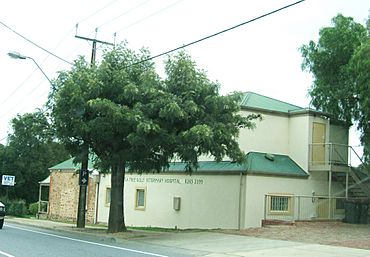Tea Tree Gully, South Australia facts for kids
Quick facts for kids Tea Tree GullyAdelaide, South Australia |
|||||||||||||||
|---|---|---|---|---|---|---|---|---|---|---|---|---|---|---|---|
 |
|||||||||||||||
| Postcode(s) | 5091 | ||||||||||||||
| Time zone | ACST (UTC+9:30) | ||||||||||||||
| • Summer (DST) | ACST (UTC+10:30) | ||||||||||||||
| Location | 22 km (14 mi) from Adelaide CBD | ||||||||||||||
| LGA(s) | City of Tea Tree Gully | ||||||||||||||
| Region | Northern Adelaide | ||||||||||||||
| County | Adelaide | ||||||||||||||
| State electorate(s) | Newland | ||||||||||||||
| Federal Division(s) | Makin | ||||||||||||||
|
|||||||||||||||
| Footnotes | Adjoining suburbs | ||||||||||||||
Tea Tree Gully, often called TTG, is a suburb located in the larger city of Adelaide, South Australia. It is part of the City of Tea Tree Gully local council area. When it comes to government, it is in the Newland area for state elections and the Makin area for national elections.
Discovering Tea Tree Gully's Past
The name Tea Tree Gully comes from the 'tea trees' (Leptospermum lanigerum) that used to grow in the gully. These trees had white flowers. Early settlers would use their leaves to make a tea-like drink.
A man named John Stevens bought land here and divided it in 1850. He first called the settlement Steventon. By 1867, people used both Tea Tree Gully and Steventon. But by 1900, Steventon was no longer used. Sometimes, the name was also written as "Teatree Gully".
The local post office also changed its name many times. It opened around 1859 as Steventon Post Office. In 1872, it became Tea Tree Gully. Then in 1925, it changed to Teatree Gully. It went back to Tea Tree Gully in 1966. Finally, in 1969, it was renamed St Agnes.
The gully itself was very important. It had a gentle slope that bullock wagons could use to travel through the Mount Lofty Ranges. It also had natural springs, which helped the tea trees grow well.
Two historic buildings in Tea Tree Gully are listed on the South Australian Heritage Register. These are the Highercombe Hotel on Perseverance Road and the Old Tea Tree Gully Council Chambers on Haines Road.
The Historic Highercombe Hotel
The Highercombe Hotel was built in 1854. Its first owner and manager was William Haines. He was also the District Clerk for the Tea Tree Gully council for 37 years. Plus, he served as a Member of Parliament for six years.
In 1879, the State Government bought the building. From 1880 to 1963, it was used as a post and telegraph office. During this time, part of the building also served as a classroom for a school. It even provided homes for the Headmasters' and Postmasters' families.
From 1963 to 1967, the Tea Tree Gully Council used the building as their office and a library. In 1967, the National Trust took over the building. Their Tea Tree Gully branch restored it. Now, it is a heritage museum, showing the history of the area.


